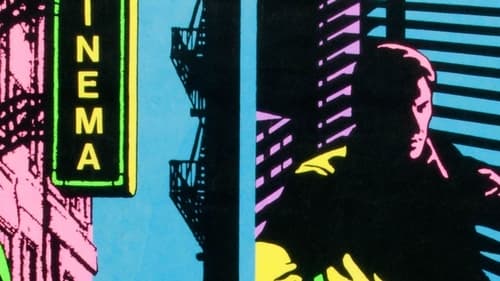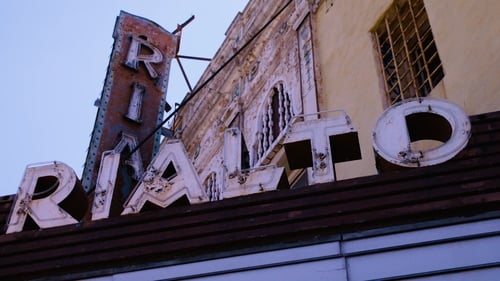The Film Inspector (2023)
Inspect the unexpected
Genre : Mystery, Thriller
Runtime : 2M
Director : Joey Litvak
Synopsis
The Film Inspector tells the story of a film inspection like no other.

Tells the history and importance of The National Film Registry, a roll call of American cinema treasures that reflects the diversity of film, and indeed the American experience itself.

When a charming fare named Penny climbs into his cab, Harris, a world-weary taxi driver, finds himself engaged in the only kind of courtship he can have with a passenger -- one that lasts as long as her trip. That is, right up until she disappears from the back seat without a trace. When confusion gives way to reality, he resets his meter and is instantaneously transported back to the moment when she climbed into his cab. He and Penny find themselves trapped in an endlessly looping nighttime cab ride, with only each other for company, and it changes his life forever.

Through the entanglement of home videos, archival footage, and cinéma vérité, I Am Corn Puffians: Ghost Camera seizes 116 years of Toronto history to tell the tale of a documentarian's descent into artistic madness.

Among the pieces featured in Fragments are the final reel of John Ford's The Village Blacksmith (1922) and a glimpse at Emil Jannings in The Way of All Flesh (1927), the only Oscar®-winning performance in a lost film. Fragments also features clips from such lost films as Cleopatra (1917), starring Theda Bara; The Miracle Man (1919), with Lon Chaney; He Comes Up Smiling (1918), starring Douglas Fairbanks; an early lost sound film, Gold Diggers of Broadway (1929), filmed in early Technicolor, and the only color footage of silent star Clara Bow, Red Hair (1928). The program is rounded out with interviews of film preservationists involved in identifying and restoring these films. Also featured is a new interview with Diana Serra Cary, best known as "Baby Peggy", one of the major American child stars of the silent era, who discusses one of the featured fragments, Darling of New York (1923).

A second generation cameraman in Australia finds evidence that his father had filmed a nuclear test that allowed aboriginies to be exposed to and killed by radiation. He begins a search for a secret that if true, his government has already killed people to keep quiet.

As notions of civil rights transformed across the world, so was the screen landscape reformed by the ascension of grassroots film movements seeking to challenge the mainstream. Some aspired to push form to its limit; others worked to destabilise what they saw as a homogenous industry, or to provoke questions around gender, sexuality, migration and race.

Celebrating the splendor and grandeur of the great cinemas of the United States, built when movies were the acme of entertainment and the stories were larger than life, as were the venues designed to show them. The film also tracks the eventual decline of the palaces, through to today’s current preservation efforts. A tribute to America’s great art form and the great monuments created for audiences to enjoy them in.

Quebec, on the cusp of the 1960s. The province is on the brink of momentous change. Deftly selecting clips from nearly 200 films from the National Film Board of Canada archives, director Luc Bourdon reinterprets the historical record, offering us a new and distinctive perspective on the Quiet Revolution.

Documentary about the lost 1914 film "Sperduti nel buio". Film historian Denis Lotto journeys across Europe following the trail of the lost movie.

Made possible through a unique UK-wide collaboration of national and regional publicly-funded film archives, Lost Connections draws on a century of archive footage that invites reflections on loss, loneliness, isolation, and expressions of desire, optimism, hope and renewal. It is not a film about the pandemic, it is a film about recovery, the human character, sadness and joy, what we really value, and our gradual reconnection with each other, our communities, and the world around us.

A collection of bloopers and outtakes from an enormous selection of Hollywood classic productions spanning from the 1930s through the 1980s.

To produce speech, a set of mechanisms must be brought together. What is the normal articulation for speech? How to produce the sounds that make it up in the correct way? A physiological analysis of the aspects of speech shows us how: the jaw must move in a certain way; the air must be expelled from the lungs in another. Based on the concepts stated in the film "Normal Speech Articulation" (1965), produced by the University of Iowa (USA), we intend to reflect on the way women have been represented, and consequently educated, over the years, both in film and in the media. Largely composed of archival footage, this film intends to make evident, through a montage inspired by Structuralist movements, the violence of this education.

Documentary on the rise and fall of the Danish silent film industry.

A documentary on Cosme Alves Netto (1937-1996), former head of the Cinematheque of the Museum of Modern Arts at Rio de Janeiro.

Luiz Roberto Galizia died very young, but he left behind a wealth of personal archives. 30 years later, his niece Ana Galizia plunges into these archives to follow the traces of this uncle she never met.

Introduction to an extensive training program for everyone professionally involved in the process of film conservation and film restoration. The realization of this training program was initiated and coordinated by ECIPAR (Bologna-Italy) and the Cineteca del Comune di Bologna. It was produced in co-operation with eleven European film archives and film laboratories and co-financed by the FILM project - FORCE program of the European Community.

“Marilyn vs. Marilyn” tells the story of a little-known period of Marilyn’s life – the years she spent in New York, trying to became a ‘serious”’ actress, taking lessons with Lee Strasberg and setting up a production company with her photographer and trusted friend, Milton Green. Based on hitherto unpublished – and magical - photos from the Greene archives, the film focuses on the photographic image of a woman who remains one of the greatest legends in the history of cinema… and an enduring enigma.

At the National Archive of the Moving Images in Portugal, archivists discuss the powerful bond between people and a machine that preserves a very delicate medium.

In this John Nesbitt's Passing Parade short, a look is taken at the problems of film preservation efforts in the 1930s and early 1940s.

This John Nesbitt's Passing Parade series short highlights the film preservation efforts of the Museum of Modern Art in New York. Several scenes from early newsreels are shown.

















